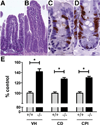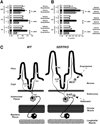Neuronal serotonin regulates growth of the intestinal mucosa in mice
- PMID: 22609381
- PMCID: PMC3687781
- DOI: 10.1053/j.gastro.2012.05.007
Neuronal serotonin regulates growth of the intestinal mucosa in mice
Erratum in
- Gastroenterology. 2013 Jan;144(1):249. Li, Zhishan [added]
Abstract
Background & aims: The enteric abundance of serotonin (5-HT), its ability to promote proliferation of neural precursors, and reports that 5-HT antagonists affect crypt epithelial proliferation led us to investigate whether 5-HT affects growth and maintenance of the intestinal mucosa in mice.
Methods: cMice that lack the serotonin re-uptake transporter (SERTKO mice) and wild-type mice were given injections of selective serotonin re-uptake inhibitors (gain-of-function models). We also analyzed mice that lack tryptophan hydroxylase-1 (TPH1KO mice, which lack mucosal but not neuronal 5-HT) and mice deficient in tryptophan hydroxylase-2 (TPH2KO mice, which lack neuronal but not mucosal 5-HT) (loss-of-function models). Wild-type and SERTKO mice were given ketanserin (an antagonist of the 5-HT receptor, 5-HT(2A)) or scopolamine (an antagonist of the muscarinic receptor). 5-HT(2A) receptors and choline acetyltransferase were localized by immunocytochemical analysis.
Results: Growth of the mucosa and proliferation of mucosal cells were significantly greater in SERTKO mice and in mice given selective serotonin re-uptake inhibitors than in wild-type mice, but were diminished in TPH2KO (but not in TPH1KO) mice. Ketanserin and scopolamine each prevented the ability of SERT knockout or inhibition to increase mucosal growth and proliferation. Cholinergic submucosal neurons reacted with antibodies against 5-HT(2A).
Conclusions: 5-HT promotes growth and turnover of the intestinal mucosal epithelium. Surprisingly, these processes appear to be mediated by neuronal, rather than mucosal, 5-HT. The 5-HT(2A) receptor activates cholinergic neurons, which provide a muscarinic innervation to epithelial effectors.
Copyright © 2012 AGA Institute. Published by Elsevier Inc. All rights reserved.
Conflict of interest statement
Conflicts of interest
These authors disclose the following: Kara Margolis and Michael Gershon received research support from Lexicon Genetics, and Michael Gershon is also a consultant for The Dannon Company, Inc. The remaining authors disclose no conflicts.
Figures







References
-
- Gershon MD, Tack J. The serotonin signaling system: from basic understanding to drug development for functional GI disorders. Gastroenterology. 2007;132:397–414. - PubMed
-
- Furness JB. The enteric nervous system. Malden, MA: Blackwell Publishing; 2006.
-
- Erspamer V. Pharmacology of indolealklyamines. Pharmacol Rev. 1954;6:425–487. - PubMed
-
- Vialli M. Histology of the enterochromaffin cell system. In: Erspamer V, editor. Handbook of experimental pharmacology: 5-hydroxytryptamine and related indolealkylamines. Volume 19. New York: Springer-Verlag; 1966. pp. 1–65.
-
- Gershon MD, Drakontides AB, Ross LL. Serotonin: synthesis and release from the myenteric plexus of the mouse intestine. Science. 1965;149:197–199. - PubMed
Publication types
MeSH terms
Substances
Grants and funding
LinkOut - more resources
Full Text Sources
Other Literature Sources
Molecular Biology Databases

